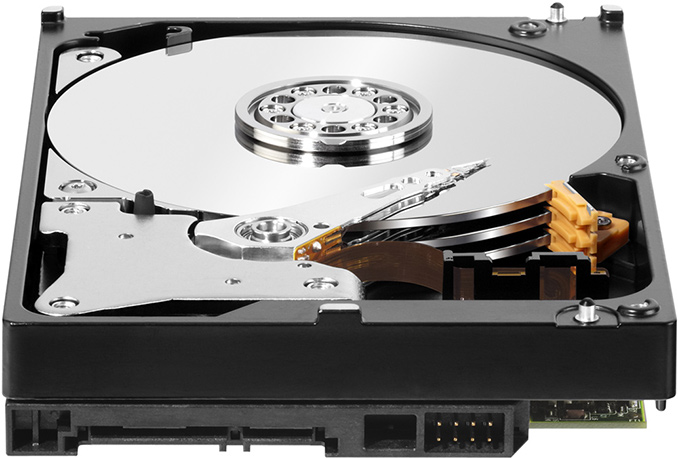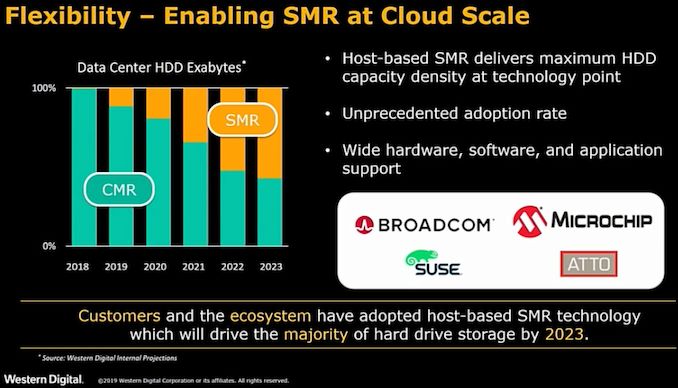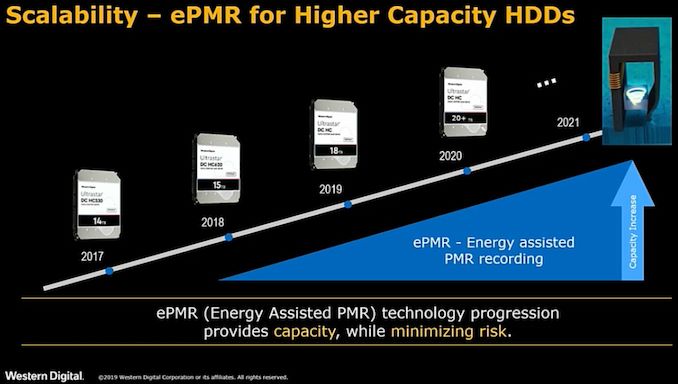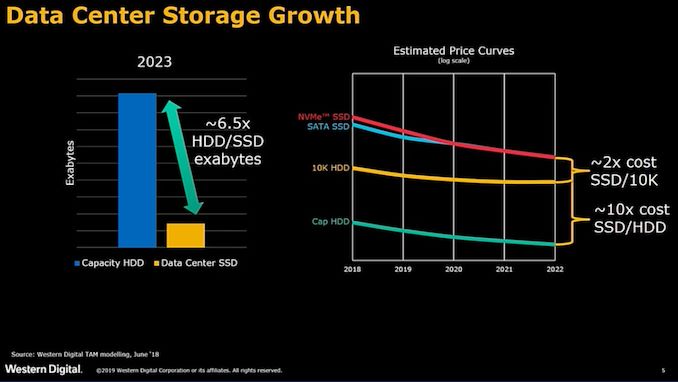Western Digital: Over Half of Data Center HDDs Will Use SMR by 2023
by Anton Shilov on March 19, 2019 10:30 AM EST- Posted in
- HDDs
- Storage
- Western Digital
- SMR
- MAMR

Western Digital said at OCP Global Summit last week that over half of hard drives for data centers will use shingled magnetic recording (SMR) technology in 2023. At present Western Digital is the only supplier of SMR HDDs managed by hosts, but the technology is gaining support by hardware, software, and applications.
SMR technology to boost capacity of hard drives fairly easily but at the cost of some performance trade-offs due to the read-modify-write cycle introduced by shingled tracks. Since operators of datacenters are interested in maximizing their storage capacities, they are inclined to invest in software that can mitigate peculiarities of SMR. As a result, several years after Western Digital introduced its first host-managed SMR HDDs, more and more companies are adopting them. Right now, the vast majority of datacenter hard drives are based on perpendicular magnetic recording technology, but WD states that in four years SMR HDDs will leave PMR drives behind.
Obviously, usage of SMR will not be the only method to increase capacities of hard drives. Energy-assisted PMR technologies (e.g., MAMR, HAMR, etc.) will also be used by Western Digital. In the coming quarters the company intends to release MAMR-based HDDs featuring a 16 TB (ePMR) and 18 TB (eSMR) capacity. The company also plans to introduce 20 TB HDDs in 2020.
High-capacity hard drives are not going to be replaced by high-capacity SSDs any time soon, according to Western Digital. HDDs will continue to cost significantly less than SSDs on per-TB basis. Therefore, they will be used to store 6.5 times more data than datacenter SSDs in 2023.
Related Reading:













33 Comments
View All Comments
brakdoo - Tuesday, March 19, 2019 - link
HDD drives are only needed for vids posted on youtube, facebook and similar sites. That's write once read many times operations where SMR makes sense. Basically every other HDD usage is getting replaced by flash...Batmeat - Tuesday, March 19, 2019 - link
similar sites to youtube and facebook? You are totally wrong. Any data center or large company requiring massive storage (especially secure storage) will continue to utilize platter based drives for years to come until a cheaper and better solution is available to cause migration of the standard.brakdoo - Tuesday, March 19, 2019 - link
Any large company requires massive storage? What kind of data do they generate where enterprise SSDs are not enough?GreenReaper - Tuesday, March 19, 2019 - link
It's not whether you can fill a server with SSDs, it's whether it makes financial sense to do so. "Enterprise SSDs" are at a premium to "Enterprise HDDs". If you're storing a significant amount of data, especially for a free-to-use service, you're probably still using HDDs.This is liable to change, but we have not yet reached the tipping point.
jabber - Tuesday, March 19, 2019 - link
Hahaha been in business 10 years now.My business data? 236MB! I bet some here would try to sell me a $10000 server.
flyingpants265 - Tuesday, March 19, 2019 - link
Good for you, man!jabber - Tuesday, March 19, 2019 - link
Joking aside, it is great not having a data millstone round your neck!GreenReaper - Tuesday, March 19, 2019 - link
That's fine. But almost by definition, since you have little data you probably aren't going to need lots of servers to store them. For people who do, it's generally because one server isn't big enough, so density of storage is at least a partial requirement - and therefore, many servers have had HDDs.mode_13h - Tuesday, March 19, 2019 - link
Clearly, you don't consider email part of your "business data".Samus - Wednesday, March 20, 2019 - link
I just checked my business folder and its around 10GB but thats due to pictures of projects and stuff.My invoice database is 700kb and my taxes (1099's, W2's, etc, PDF's and all) for the last 10 years only amount to 50MB.
Data is surprisingly small until you get into video.